What kind of light do we see? What is light
) radiation, with the maximum sensitivity at 555 nm (540 Hz), in the green part of the spectrum. Since the sensitivity drops to zero gradually with distance from the maximum point, it is impossible to indicate the exact boundaries of the spectral range of visible radiation. Usually, a section of 380-400 nm (790-750 Hz) is taken as a short-wave boundary, and 760-780 nm (395-385 THz) as a long-wave boundary. Electromagnetic radiation with these wavelengths is also called visible light , or simply light(in the narrow sense of the word).
Story
The first explanations of the causes of the visible radiation spectrum were given by Isaac Newton in the book Optics and Johann Goethe in The Theory of Colors, but even before them, Roger Bacon observed the optical spectrum in a glass of water. Only four centuries later did Newton discover the dispersion of light in prisms.
Newton was the first to use the word spectrum (lat. spectrum- vision, appearance) in print in 1671, describing his optical experiments. He discovered that when a beam of light hits the surface of a glass prism at an angle to the surface, some of the light is reflected and some passes through the glass, forming bands of different colors. The scientist suggested that light consists of a stream of particles (corpuscles) of different colors, and that particles of different colors move in a transparent medium at different speeds. According to his assumption, red light traveled faster than violet, and therefore the red beam was not deflected on the prism as much as violet. Because of this, a visible spectrum of colors arose.
Newton divided light into seven colors: red, orange, yellow, green, blue, indigo and violet. The number seven he chose from the belief (derived from the ancient Greek sophists) that there is a connection between colors, musical notes, objects in the solar system, and the days of the week. The human eye is relatively weakly sensitive to indigo frequencies, so some people cannot distinguish it from blue or purple. Therefore, after Newton, it was often proposed to consider indigo not an independent color, but only a shade of violet or blue (however, it is still included in the spectrum in the Western tradition). In the Russian tradition, indigo corresponds to blue.
Goethe, unlike Newton, believed that the spectrum arises when different constituent parts Sveta. Observing wide beams of light, he found that when passing through a prism, red-yellow and blue edges appear at the edges of the beam, between which the light remains white, and the spectrum appears if these edges are brought close enough to each other.
Wavelengths corresponding to different colors of visible radiation were first introduced on November 12, 1801 in Baker's lecture
- electromagnetic waves perceived by the human eye. The sensitivity of the human eye to electromagnetic radiation depends on the wavelength (frequency) of the radiation, with a maximum sensitivity at 555 nm (540 terahertz), in the green part of the spectrum. Since the sensitivity drops to zero gradually with distance from the maximum point, it is impossible to indicate the exact boundaries of the spectral range of visible radiation. Usually, a section of 380-400 nm (750-790 THz) is taken as a short-wave boundary, and 760-780 nm (385-395 THz) as a long-wave boundary. Electromagnetic radiation with such wavelengths is also called visible light, or simply light (in the narrow sense of the word).
Visible radiation also enters the "optical window", the region of the spectrum electromagnetic radiation practically not absorbed by the Earth's atmosphere. Clean air scatters blue light much more than light with longer wavelengths (towards the red end of the spectrum), so the midday sky looks blue.
Many species of animals are able to see radiation that is not visible to the human eye, that is, not included in the visible range. For example, bees and many other insects see light in the ultraviolet range, which helps them find nectar on flowers. Plants pollinated by insects are in a better position in terms of procreation if they are bright in the ultraviolet spectrum. Birds are also able to see ultraviolet light (300-400 nm), and some species even have markings on their plumage to attract a partner, visible only in ultraviolet light.
- 1. History
- 2 Characteristics of the boundaries of visible radiation
- 3 Visible spectrum
- 4 See also
- 5 Notes
Story
Newton's circle of colors from Optics (1704), showing the relationship between colors and musical notes. The colors of the spectrum from red to violet are separated by notes, starting with re (D). The circle makes up a full octave. Newton placed the red and violet ends of the spectrum next to each other, emphasizing that mixing red and violet produces purple.The first explanations of the spectrum of visible radiation were given by Isaac Newton in the book "Optics" and Johann Goethe in the work "Theory of Colors", but even before them, Roger Bacon observed the optical spectrum in a glass of water. Only four centuries after this, Newton discovered the dispersion of light in prisms.
Newton first used the word spectrum (lat. spectrum - vision, appearance) in print in 1671, describing his optical experiments. He made the observation that when a beam of light hits the surface of a glass prism at an angle to the surface, some of the light is reflected and some passes through the glass, forming bands of different colors. The scientist suggested that light consists of a stream of particles (corpuscles) of different colors, and that particles of different colors move at different speeds in a transparent medium. According to his assumption, red light traveled faster than violet, and therefore the red beam was not deflected on the prism as much as violet. Because of this, a visible spectrum of colors arose.
Newton divided light into seven colors: red, orange, yellow, green, blue, indigo, and violet. The number seven he chose from the belief (derived from the ancient Greek sophists) that there is a connection between colors, musical notes, objects solar system and days of the week. The human eye is relatively weakly sensitive to indigo frequencies, so some people cannot distinguish it from blue or purple. Therefore, after Newton, it was often proposed to consider indigo not an independent color, but only a shade of violet or blue (however, it is still included in the spectrum in the Western tradition). Russian tradition indigo corresponds to the blue color.
Goethe, unlike Newton, believed that the spectrum arises when different components of light are superimposed. Observing wide beams of light, he found that when passing through a prism, red-yellow and blue edges appear at the edges of the beam, between which the light remains white, and the spectrum appears if these edges are brought close enough to each other.
The wavelengths corresponding to the different colors of visible radiation were first introduced on November 12, 1801 in the Baker Lecture by Thomas Young, and were obtained by converting into wavelengths the parameters of Newton's rings measured by Isaac Newton himself. Newton obtained these rings by passing through a lens lying on a flat surface corresponding to the desired color of a part of the light spread out by a prism into a spectrum of light, repeating the experiment for each of the colors: 30-31. Jung presented the obtained wavelengths in the form of a table, expressed in French inches (1 inch = 27.07 mm), being converted to nanometers, their values correspond well to modern ones adopted for various colors. 1821 Josef Fraunhofer pioneered the measurement of wavelengths spectral lines, having received them from the visible radiation of the Sun using a diffraction grating, measuring the diffraction angles with a theodolite and converting them to wavelengths. Like Jung, he expressed them in French inches, converted to nanometers, they differ from modern ones by units: 39-41. Thus, even in early XIX century, it became possible to measure the wavelengths of visible radiation with an accuracy of several nanometers.
In the 19th century, after the discovery of ultraviolet and infrared radiation, the understanding of the visible spectrum became more accurate.
In the early 19th century, Thomas Jung and Hermann von Helmholtz also explored the relationship between the visible spectrum and color vision. Their theory of color vision correctly assumed that it uses three different kind receptors.
Characteristics of the boundaries of visible radiation
Visible spectrum
When a white beam is decomposed in a prism, a spectrum is formed in which radiation of different wavelengths is refracted at different angles. The colors included in the spectrum, that is, those colors that can be obtained using light of one wavelength (more precisely, with a very narrow range of wavelengths), are called spectral colors. The main spectral colors (having their own name), as well as the emission characteristics of these colors, are presented in the table:
| Color | Wavelength range, nm | Frequency range, THz | Photon energy range, eV |
|---|---|---|---|
| Violet | 380-440 | 680-790 | 2,82-3,26 |
| Blue | 440-485 | 620-680 | 2,56-2,82 |
| Blue | 485-500 | 600-620 | 2,48-2,56 |
| Green | 500-565 | 530-600 | 2,19-2,48 |
| Yellow | 565-590 | 510-530 | 2,10-2,19 |
| Orange | 590-625 | 480-510 | 1,98-2,10 |
| Red | 625-740 | 400-480 | 1,68-1,98 |
see also
- Spectral and Complementary Colors
Notes
- 1 2 Gagarin A. P. Light // Physical Encyclopedia / D. M. Alekseev, A. M. Baldin, A. M. Bonch-Bruevich, A. S. Borovik-Romanov, B. K. Vainshtein, S. V. Vonsovsky , A. V. Gaponov-Grekhov, S. S. Gershtein, I. I. Gurevich, A. A. Gusev, M. A. Elyashevich, M. E. Zhabotinsky, D. N. Zubarev, B. B. Kadomtsev , I. S. Shapiro, D. V. Shirkov; under total ed. A. M. Prokhorova. - M.: Soviet Encyclopedia, 1994. - T. 4. - S. 460. - 704 p. - 40,000 copies.
- GOST 8.332-78. State system ensuring the uniformity of measurements. Light measurements. Values of the relative spectral luminous efficiency of monochromatic radiation for daytime vision
- GOST 7601-78. Physical optics. Terms, letter designations and definitions of basic quantities
- Cuthill Innes C. Ultraviolet vision in birds // Advances in the Study of Behavior / Peter J.B. Slater. - Oxford, England: Academic Press. - Vol. 29. - P. 161. - ISBN 978-0-12-004529-7.
- Jamieson Barrie G. M. Reproductive Biology and Phylogeny of Birds. - Charlottesville VA: University of Virginia. - P. 128. - ISBN 1578083869.
- 1 2 Newton I. Optics or a treatise on reflections, refractions, bendings and colors of light / Translated by Vavilov S. I. - 2nd ed. - M.: State. Publishing house of technical and theoretical literature, 1954. - S. 131. - 367 p. - (series "Classics of natural science").
- Coffee Peter. The Science of Logic: An Inquiry Into the Principles of Accurate Thought. — Longmans, 1912.
- Hutchison, Niels Music For Measure: On the 300th Anniversary of Newton's Opticks. Color Music (2004). Retrieved August 11, 2006. Archived from the original on February 20, 2012.
- 1 2 John Charles Drury Brand. Lines Of Light: The Sources Of. - CRC Press, 1995.
- Thomas Young (1802). The Bakerian Lecture. On the Theory of Light and Colors. Philosophical Transactions of the Royal Society of London for the Year 1802: 39.
- Fraunhofer Jos. (1824). "Neue Modifikation des Lichtes durch gegenseitige Einwirkung und Beugung der Strahlen, und Gesetze derselben". Denkschriften der Königlichen Akademie der Wissenschaften zu München für die Jahre 1821 and 1822 VIII: 1-76.
- Thomas J. Bruno, Paris D. N. Svoronos. CRC Handbook of Fundamental Spectroscopic Correlation Charts. CRC Press, 2005.
| electromagnetic spectrum | |
|---|---|
| γ-radiation | x-ray | UV | visible light| IR | terahertz radiation | microwaves | radio waves | |
| Visible spectrum | purple | blue | blue | green | yellow | orange | red |
| Microwave | w | v | Q | Ka | K | Ku | x | c | S | L |
| radio waves | EHF/EHF | microwave/SHF | UHF/UHF | VHF/VHF | HF/HF | MF/MF | LF/LF | VLF/VLF | INCH/ULF | SLF/SLF | ELF/ELF |
| Wavelengths | Ultrashort waves | Short waves | Medium waves | Long waves |
Visible radiation Information about
Visible radiation Information Video
View topic.
Visible radiation what, Visible radiation who, Visible radiation explanation
energy E — 1,7-3,3 eV
temperature T- 4-8 thousand. To
frequency ν ( nude) - 4-8 10 14 Hz
wavelength λ ( lambda) — 380-730 nm
Range visible light- the narrowest in the entire spectrum. The wavelength in it changes less than twice. Visible light accounts for the maximum radiation in the spectrum of the Sun. Our eyes in the course of evolution have adapted to its light and are able to perceive radiation only in this narrow part of the spectrum. Almost all astronomical observations until the middle of the 20th century were carried out in visible light. The main source of visible light in space is the stars, the surface of which is heated to several thousand degrees and therefore emits light. On Earth, non-thermal light sources are also used, such as fluorescent lamps and semiconductor light-emitting diodes.
Mirrors and lenses are used to collect light from weak cosmic sources. Visible light receivers are the retina, photographic film, semiconductor crystals (CCD arrays) used in digital cameras, photocells and photomultipliers. The principle of operation of the receivers is based on the fact that the energy of a quantum of visible light is sufficient to provoke chemical reaction in a specially selected substance or to knock out a free electron from a substance. Then, the amount of light received is determined by the concentration of the reaction products or by the magnitude of the released charge.
Sources
One of the brightest comets of the late 20th century. It was discovered in 1995, when it was still beyond the orbit of Jupiter. This is a record distance for detection new comet. It passed perihelion on April 1, 1997, and at the end of May it reached its maximum brightness - about zero magnitude. In total, the comet remained visible to the naked eye for 18.5 months - twice the previous record set by the great comet of 1811. The image shows two tails of the comet - dusty and gaseous. The pressure of solar radiation directs them away from the Sun.
![]()
The second largest planet in the solar system. Belongs to the class of gas giants. The picture was taken by the Cassini interplanetary station, which has been conducting research in the Saturn system since 2004. At the end of the 20th century, ring systems were found in all giant planets - from Jupiter to Neptune, but only in Saturn they are easily accessible even with a small amateur telescope.

Regions of low temperature on the visible surface of the Sun. Their temperature is 4300–4800 To- about one and a half thousand degrees lower than on the rest of the surface of the Sun. Because of this, their brightness is 2–4 times lower, which in contrast creates the impression of black spots. Sunspots occur when the magnetic field slows down convection and thus the removal of heat in the upper layers of the Sun's matter. They live from several hours to several months. The number of spots serves as an indicator of solar activity. By observing the spots for several days, it is easy to notice the rotation of the Sun. The picture was taken with an amateur telescope.
Attention! In no case should you look at the Sun through a telescope or other optical device without special protective filters. When using filters, they should be securely attached in front of the objective and not at the instrument's eyepiece, where the filter could be damaged by overheating. In any case, it is safer to observe the projection of the image of the Sun on a sheet of paper behind the eyepiece of the telescope.

Contains about 3 thousand stars, of which seven are visible to the naked eye. The cluster is 13 light years across and is located 400 light years from Earth. Open clusters are formed during the compression of cosmic gas and dust clouds under the action of self-gravity (the attraction of some parts of the cloud to others). During compression, the cloud breaks up into pieces, from which individual stars are formed. These stars are weakly bound together by gravity, and over time, such clusters dissipate.
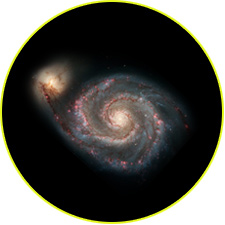
A spiral galaxy whose disk we observe flat on, also known as the Whirlpool. Located at a distance of about 37 million light years. Its diameter is about 100 thousand light years. At the end of one of the spiral arms is a companion galaxy.
The designation M51 refers to the entire pair as a whole. Separately, the main galaxy and its companion are designated NGC 5194 and 5195. The gravitational interaction with the companion condenses the gas in the parts of the spirals close to it, which accelerates star formation. Interaction is a typical phenomenon in the world of galaxies. The galaxy is visible through a small amateur telescope.
Receivers

Visual observations are no longer used in professional astronomy. About 20 years ago they were completely supplanted by digital photography, photometry, spectrometry and computer data processing.
However, the romance of visual observations still inspires astronomy lovers. The Sun, Moon, five planets, about 6 thousand stars and four galaxies are available to the naked eye - Milky Way, Andromeda Nebula, Large and Small Magellanic Clouds. Appear occasionally visible to the eye comets and asteroids.
Almost every night you can observe cosmic grains of sand - meteors burning in the atmosphere, as well as slowly crawling across the sky artificial satellites Earth. In high latitudes, auroras are observed, in low latitudes, under favorable conditions, a ghostly zodiacal light is visible - cosmic dust illuminated by the Sun. And all this diversity is observed in an extremely narrow spectral range, which is almost a thousand times narrower than the infrared range.
With binoculars, you can see dozens of times more stars and many nebulous objects. An amateur telescope has access to thousands of times more stars, details on the surface of planets, their satellites, as well as hundreds of nebulae and galaxies. But at the same time, the field of view of the telescope is much smaller, and for successful observations it must be securely fixed, and even better, slowly rotated following the rotation of the sky.
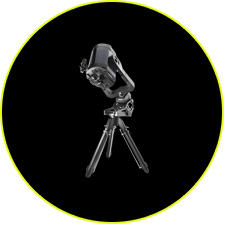
AT modern world amateur astronomy has become a fascinating and prestigious hobby. A number of companies, such as Meade and Celestron, make telescopes specifically for hobbyists. The simplest instruments with a lens diameter of 50–70 mm cost 200-500 dollars, the largest with a diameter of 350-400 mm comparable in cost to a prestigious car and require permanent installation on a concrete foundation under the dome. In skillful hands, such tools may well contribute to great science.
The most popular amateur telescopes in the world have a diameter of about 200 mm and built according to the optical design invented by the Soviet optician Maksutov. They have a short tube, which is usually mounted on a forked mount and equipped with a computer to automatically aim at various objects according to their celestial coordinates. Such a tool is shown on the poster.

In 1975, the 6-meter BTA telescope was built in the USSR. So that the main mirror of the telescope does not deform, it was made about a meter thick. It seemed that it was impossible to increase the size of the mirrors further. However, a solution was found. Mirrors began to be made relatively thin (15–25 cm) and unload on a set of supports, the position of which is controlled by a computer. The ability to bend mirrors, flexibly adjusting their shape, made it possible to build telescopes up to 8 meters in diameter.
But the astronomers did not stop there. On the largest instruments, the mirrors are divided into segments, combining the position of the parts with an accuracy of hundredths of a micron. This is how the world's largest 10-meter Keck telescopes are arranged. The next step will be the American Magellan telescope, which will have 7 mirrors, each with a diameter of 8 meters. Together they will work as a 24-meter telescope. And in the European Union, work has begun on an even more ambitious project - a telescope with a diameter of 42 meters.
The main obstacle to realizing the capabilities of such instruments is the earth's atmosphere, the turbulence of which distorts the image. To compensate for interference, special equipment constantly monitors the state of the atmosphere and, on the go, bends the telescope mirror in such a way as to compensate for distortions. This technology is called adaptive optics.
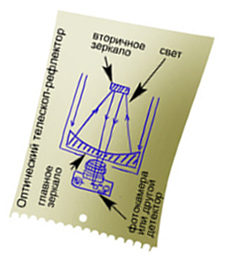
The telescope has two tasks: to collect as much light from a weak source as possible and to distinguish as small details as possible. The light-gathering ability of a telescope is determined by the area of the primary mirror, and the resolving power is determined by its diameter. That is why astronomers strive to build the largest possible telescopes.
For small telescopes, a converging lens (refractor telescope) can be used as an objective, but a concave parabolic mirror (reflecting telescope) is more commonly used. The main function of the lens is to build an image of the observed sources in the focal plane of the telescope, where the camera or other equipment is located. In amateur telescopes for visual observations, an eyepiece is placed behind the focal plane, which is, in fact, a strong magnifying glass through which the image created by the lens is viewed.
However, the focal plane of the reflector is in front of the mirror, which is not always convenient for observations. Various techniques are used to bring the beam of light out of the telescope tube. In Newton's system, a diagonal mirror is used for this. In more complex system Cassegrain (on the poster), opposite the main mirror, a secondary convex mirror in the form of a hyperboloid of revolution is placed. It reflects the beam back, where it exits through a hole in the center of the primary mirror. In the Maksutov system, a thin convex-concave lens is placed at the front end of the telescope tube. It not only protects the telescope mirrors from damage, but also makes it possible to make the primary mirror spherical rather than parabolic, which is much cheaper to manufacture.
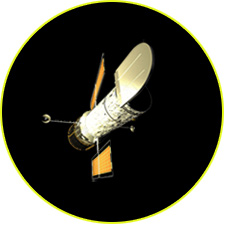
The largest orbital optical telescope. The diameter of its main mirror is 2.4 meters. Launched into orbit in 1991. Can conduct observations in the visible, near infrared and near ultraviolet ranges. The only space telescope visited by astronauts for repairs and maintenance.
Astronomy owes dozens of discoveries to the Hubble telescope. Among other things, he made it possible to see what galaxies looked like at the time of their birth about 13 billion years ago. Currently, the Hubble telescope is being replaced by a new generation space telescope - the James Webb Space Telescope (JWST) with a diameter of 6.5 meters, which is scheduled to be launched into space in 2013. True, it will not work in the visible range, but in the near and middle infrared.
The spectral line H-alpha corresponds to the transition of an electron in a hydrogen atom from the third energy level On the second.
This is the first line of the so-called Balmer series, which consists entirely of transitions from different high levels On the second. There are similar series of transitions to the first level (Lyman series), to the third level (Paschen series), and to other levels. A distinctive feature of the Balmer series is that it is located almost entirely in the visible range, which greatly facilitates observations. In particular, the H-alpha line falls in the red part of the spectrum.
The radiation in this line arises in rarefied cosmic clouds of atomic hydrogen. The atoms in them are excited by ultraviolet radiation from hot stars, and then give off energy, moving to lower levels. By isolating the H-alpha line with filters, one can purposefully observe the distribution of neutral hydrogen.
A sky survey in the H-alpha line shows the distribution of gas in our Galaxy. It shows large bubbles of gas around regions of active star formation.
Earth application
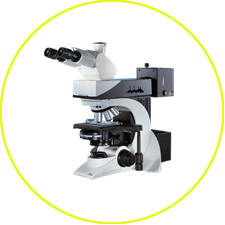
When viewing objects at a distance of clear vision (25 cm) a person can distinguish details of about 0.1 mm(the angular resolution of the eye is of the order of one arc minute 1" = 2.3 × 10 -4 rad). To see more small parts, you need to look from a smaller distance, but at a distance of less than 10 cm it is very difficult for the eye to adjust.
This can be achieved by using a magnifying glass, the optical power of which is added to the optical power of the lens. But even in this case, the magnification limit is approximately 25x, since the size of such a strong magnifying glass becomes very small and it has to be placed close to the sample. In fact, such a magnifying glass becomes a microscope objective. It is very inconvenient to look into it with the eye, but you can do otherwise.
By carefully adjusting the distance from the lens to the object, you can get an enlarged image of it at some distance behind the lens. By placing another magnifying glass behind it and examining the image built by the lens through it, one can achieve magnification of hundreds and even more than a thousand times.
However, magnifications noticeably more than 1000 times do not have practical sense, since the wave nature of light does not allow us to consider details smaller than the wavelength (400–700 nm). At a magnification of 2000 times, such details are visible as millimeter divisions on the ruler that you hold in your hands.
Increasing the magnification further will not reveal any new details to you. To see high resolution details, you need X-rays with a shorter wavelength or, in general, electron flows, in which (according to quantum mechanics) the wavelength is shorter. You can also use a mechanical probe with a very precise aiming system - the so-called scanning microscope.
Visible radiation is a spectrum of electromagnetic oscillations of a long wave from 400 to 750 nm, consisting of seven colors (orange, red, yellow, blue, blue, violet, green). This type irradiation is able to cause physico-chemical reactions in the body that are close in energy parameters to , and is used together with it. The use of visible radiation for therapeutic and prophylactic purposes is called chromotherapy.
Action on the body

Visible radiation quanta have a high frequency and high energy. This gives them the opportunity to transfer atoms to an excited state and increase their ability to biochemical interactions. The biological effect of radiation depends on the depth of its penetration into the tissues. It penetrates the skin to a depth of one centimeter and is absorbed by the surface of the skin. In this case, heat is released, which changes local metabolic processes and causes segmental reactions. As a result, microcirculation and tissue nutrition are improved, immunogenesis and the release of biologically active substances into the blood are activated. Important influence the method affects a person through the retina of the eye, as it is perceived through the organ of vision, having a reflex and indirect effect on the central nervous system, and as a result, on the mental processes in the body.
color treatment

The color effect on a person is multifaceted. It is believed that orange, yellow and red are active colors, while blue and violet are passive. It has been established that active colors are tiring, while green and blue are invigorating. At the same time, orange and red have an exciting effect on the body, blue - inhibitory, and green and yellow balance these processes. There is an opinion that Orange color stimulates the kidneys, yellow color normalizes arterial pressure and the functioning of the digestive system. Green color normalizes the work of the heart, and purple and blue - the functioning of the brain. Blue spectrum radiation promotes the breakdown of hematoporphyrins and is used to treat neonatal jaundice. White color has a significant effect on the human body. It is with its lack in winter that depressive disorders can develop due to a reduction in daylight hours.
Therapeutic effects of visible radiation
- Improvement of blood supply and tissue trophism.
- Stabilization of functioning of irradiated organs.
- metabolic effect.
- Photodestruction.
- Normalization of functioning nervous system and psycho-emotional state of the patient.
Indications for use
- Diseases of the peripheral nervous system (neuritis, radicular syndrome).
- and muscles.
- Consequences of traumatic damage to the joints, ligamentous apparatus.
- Pathological processes of internal organs of an inflammatory nature.
- Contractures, infiltrates.
- Long-term healing wounds.
- Frostbite.
Chromotherapy using red and blue is used in dermatology for the treatment of acne.
Contraindications
- Photophthalmia (acute eye damage due to radiation).
- Acute purulent inflammatory processes.
- Bleeding.
- Blood diseases.
- Circulatory failure.
- Active .
- Malignant neoplasms.
Methodology

The impact is carried out on naked parts of the human body. The light source can be solar lamps, medical reflectors, LED emitters. The distance from the reflector to the surface of the irradiation area is determined by the type and power of these sources. If the impact is carried out on the skin, then the patient's eyes should be protected with special glasses. Dosing of the procedure is carried out according to the subjective sensations of the patient and according to the energy flux density. Methods of psychophysiological assessment of color perception can be used. The duration of the procedures and their number is selected individually. The treatment session lasts about 20 minutes and is accompanied by a feeling of light warmth. The course of treatment accounts for 10 to 20 procedures that are performed every day. If necessary, repeated courses of phototherapy are prescribed after 4-5-6 weeks.
Conclusion
The therapeutic effect of visible radiation has found wide application in medicine. Chromotherapy is a safe and affordable method of treating various diseases, which has practically no side effects and complications. This method of physiotherapy can be successfully combined with other medical procedures. As a result of taking a course of phototherapy, patients feel better, their psycho-emotional state improves.
Cosmetologist Yulia Orishchenko talks about chromotherapy:
TV channel "Russia-1", the program "Morning of Russia", a story about chromotherapy:
In nature, there are no flowers as such. Each shade that we see is set by one or another wavelength. formed under the influence of the longest wavelengths and is one of the two faces of the visible spectrum.
On the nature of color
The appearance of a particular color can be explained by the laws of physics. All colors and shades are the result of the brain processing information coming through the eyes in the form of light waves. various lengths. In the absence of waves, people see, and with a simultaneous exposure to the entire spectrum - white.
The colors of objects are determined by the ability of their surfaces to absorb waves of a certain wavelength and repel all others. Lighting also matters: the brighter the light, the more intense the waves are reflected, and the brighter the object looks.
Humans are able to distinguish over one hundred thousand colors. Favorite by many scarlet, burgundy and cherry shades are formed by the longest waves. However, for the human eye to see red, it must not exceed 700 nanometers. Beyond this threshold, the infrared spectrum, invisible to humans, begins. The opposite boundary separating the violet hues from the ultraviolet spectrum is at a level of about 400 nm.
Color spectrum
The spectrum of colors, as some of their totality, distributed in ascending order of the wavelength, was discovered by Newton during his famous experiments with a prism. It was he who singled out 7 clearly distinguishable colors, and among them - 3 main ones. Red color refers to both distinguishable and basic. All the shades that people distinguish are the visible region of the vast electromagnetic spectrum. Thus, color is an electromagnetic wave of a certain length, not shorter than 400, but not longer than 700 nm.
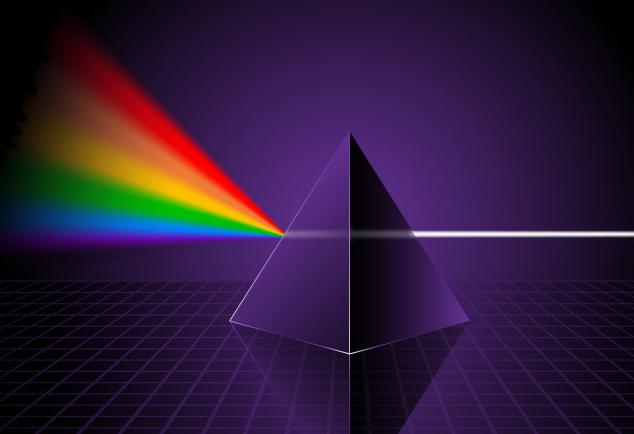
Newton noticed that beams of light of different colors had different degrees of refraction. To put it more correctly, the glass refracted them in different ways. The maximum speed of passage of rays through the substance and, as a result, the lowest refraction was facilitated by the largest wavelength. Red is the visible representation of the least refracted rays.
Waves forming red
An electromagnetic wave is characterized by such parameters as length, frequency, and Under the wavelength (λ), it is customary to understand the smallest distance between its points that oscillate in the same phases. Basic units of wavelength:
- micron (1/1000000 meters);
- millimicron, or nanometer (1/1000 micron);
- angstrom (1/10 millimicron).
The maximum possible wavelength of red is 780 microns (7800 angstroms) when passing through a vacuum. The minimum wavelength of this spectrum is 625 microns (6250 angstroms).
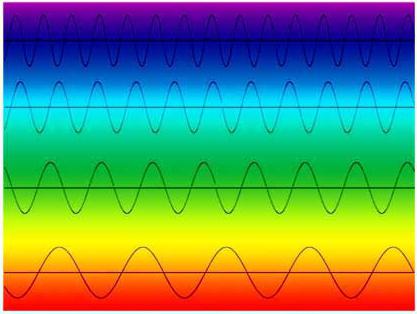
Another significant indicator is the frequency of oscillations. It is related to the length, so the wave can be set to any of these values. The frequency of red waves is in the range from 400 to 480 Hz. The photon energy in this case forms a range from 1.68 to 1.98 eV.
red color temperature
Shades that a person subconsciously perceives as warm or cold, from a scientific point of view, as a rule, have the opposite temperature regime. The colors associated with sunlight - red, orange, yellow - are usually considered warm, and the opposite colors are considered cold.
However, radiation theory proves the opposite: red shades are much lower than blue ones. In fact, this is easy to confirm: hot young stars have a bluish light, and fading stars have a red one; when heated, the metal first turns red, then yellow, and then white.
According to Wien's law, there is an inverse relationship between the degree of wave heating and its length. The more the object heats up, the more power falls on radiation from the short wave region, and vice versa. It remains only to remember where in the visible spectrum there is the largest wavelength: red takes a position that contrasts with blue tones, and is the least warm.
shades of red
Depending on the specific value that the wavelength has, the red color takes on various shades: scarlet, raspberry, burgundy, brick, cherry, etc.

Hue is characterized by 4 parameters. These are such as:
- Hue is the position that a color occupies on the spectrum among the 7 visible colors. The length of the electromagnetic wave sets the tone.
- Brightness - is determined by the strength of the radiation of energy of a certain color tone. The maximum decrease in brightness leads to the fact that a person will see black. With a gradual increase in brightness, it will appear behind it - burgundy, after - scarlet, and with a maximum increase in energy - bright red.
- Lightness - characterizes the proximity of the shade to white. White color is the result of mixing waves of different spectra. With a successive build-up of this effect, the red color will turn into crimson, then pink, then light pink and finally white.
- Saturation determines how far a color is from gray. Gray color by its nature is the three primary colors mixed in different amounts when the brightness of the light emission is reduced to 50%.






